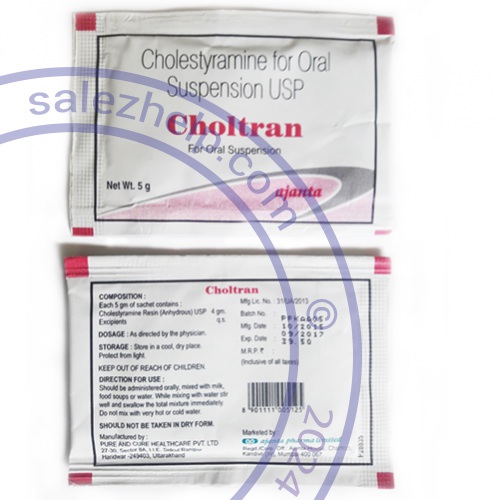





| Empaquetado | Por sachet | Precio | Compre |
|---|---|---|---|
| 4gm × 10 sachets | € 7.58 | € 75.78 | Comprar! |
| 4gm × 20 sachets | € 5.90 | € 117.90 | Comprar! |
| 4gm × 30 sachets | € 5.37 | € 160.96 | Comprar! |
| 4gm × 50 sachets | € 4.36 | € 218.06 | Comprar! |
| 4gm × 100 sachets viagra soft 100mg x 4 comprimido or cialis soft 20mg x 2 comprimido | € 4.06 | € 406.22 | Comprar! |
Cholestyramine helps reduce cholesterol (fatty acids) in the blood. High cholesterol is associated with an increased risk of heart disease and atherosclerosis (clogged arteries). Cholestyramine is used to lower high levels of cholesterol in the blood, especially low-density lipoprotein (LDL) ("bad" cholesterol). Cholestyramine powder is also used to treat itching caused by a blockage in the bile ducts of the gallbladder. Cholestyramine may also be used for purposes not listed in this medication guide.
You should not take this medication if you are allergic to cholestyramine, or if you have a blockage in your stomach or intestines.
To make sure you can safely take cholestyramine, tell your doctor if you have any of these other conditions:
a thyroid disorder;
diabetes,
kidney disease,
liver disease, or
chronic constipation.
FDA pregnancy category C. It is not known whether cholestyramine will harm an unborn baby. Tell your doctor if you are pregnant or plan to become pregnant while using this medication. Taking cholestyramine can make it harder for your body to absorb certain vitamins your body needs while you are nursing a baby. Do not take cholestyramine without telling your doctor if you are breast-feeding. This medicine may contain phenylalanine. Talk to your doctor before using cholestyramine if you have phenylketonuria (PKU).
Take exactly as prescribed by your doctor. Do not take in larger or smaller amounts or for longer than recommended. Follow the directions on your prescription label. Cholestyramine is sometimes taken up to 6 times per day. Follow your doctor's instructions.
Take cholestyramine with meals unless your doctor tells you otherwise. Mix the cholestyramine powder with 2 to 6 ounces of water or other non-carbonated beverage. You may also mix the powder with a brothy soup, crushed pineapple, or applesauce. Measure the powder using the scoop provided with your medication. Do not use any other scoop or measuring cup to measure your cholestyramine dose.
Drink extra fluids to prevent constipation while you are taking cholestyramine. It is important to take cholestyramine regularly to get the most benefit. Cholestyramine is only part of a complete program of treatment that may also include diet, exercise, and weight control. Follow your diet, medication, and exercise routines very closely. While using cholestyramine, you may need blood tests at your doctor's office. Visit your doctor regularly.
Use the missed dose as soon as you remember. Skip the missed dose if it is almost time for your next scheduled dose. Do not use extra medicine to make up the missed dose.
Cholestyramine can make it harder for your body to absorb other medications, such as:
a blood thinner such as warfarin (Coumadin, Jantoven);
digoxin (digitalis, Lanoxin);
propranolol (Inderal);
a diuretic (water pill);
thyroid hormones such as levothyroxine (Synthroid, Levoxyl, Levothroid);
birth control pills or hormone replacement;
seizure medicines such as phenytoin (Dilantin) and phenobarbital (Luminal, Solfoton); or
an antibiotic such as amoxicillin (Amoxil, Trimox, others), doxycycline (Adoxa, Doryx, Oracea, Vibramycin), minocycline (Dynacin, Minocin, Solodyn, Vectrin), penicillin (BeePen-VK, Pen-Vee K, Veetids, others), tetracycline (Brodspec, Panmycin, Sumycin, Tetracap).
This list is not complete and other drugs may interact with cholestyramine.
Avoid taking other medications at the same time you take cholestyramine. Wait at least 4 to 6 hours after taking cholestyramine before you take any other medications.
Get emergency medical help if you have any of these signs of an allergic reaction: hives; difficulty breathing; swelling of your face, lips, tongue, or throat.
Call your doctor at once if you have a serious side effect such as:
blood in your urine;
severe stomach pain;
ongoing constipation;
feeling short of breath;
black, bloody, or tarry stools; or
easy bruising or bleeding.
Less serious side effects may include:
mild constipation, diarrhea;
stomach pain, nausea, loss of appetite, weight changes;
bloating or gas;
hiccups or a sour taste in your mouth;
skin rash or itching;
irritation of your tongue;
itching or irritation around your rectal area;
muscle or joint pain; or
dizziness, spinning sensation; ringing in your ears.
This is not a complete list of side effects and others may occur.
Store cholestyramine at room temperature away from moisture and heat.